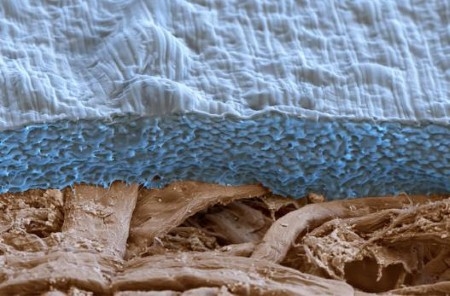 mpt customers with pizzas, vegetables and fillets of fish – well packaged in brightly colored boxes. Well designed paper packaging is essential for the food production sector because it is lightweight, space saving when stacked and can also be transported cost-effectively. At the same time, it protects the products against moisture, contamination and damage. Paper is the sustainable packaging material, particularly if produced from recycled fibers, however such fibers can contain mineral oils residues. Coating solutions from BASF protect the foods from these substances.
mpt customers with pizzas, vegetables and fillets of fish – well packaged in brightly colored boxes. Well designed paper packaging is essential for the food production sector because it is lightweight, space saving when stacked and can also be transported cost-effectively. At the same time, it protects the products against moisture, contamination and damage. Paper is the sustainable packaging material, particularly if produced from recycled fibers, however such fibers can contain mineral oils residues. Coating solutions from BASF protect the foods from these substances.Cardboard packaging for food is often produced from recycled waste paper, such as newspapers. This paper contains, among other things, residues of newspaper printing inks which include mineral oils not approved for food contact. And that's exactly where the problem lies: the mineral oils cannot be completely removed in the recycling process and consequently enter the packaging. Mineral oils contain hydrocarbon compounds which can travel from the cardboard into the foods. Experts call this migration. This can happen even without direct contact between the cardboard and the food: some mineral oil residues already evaporate at room temperature. This mixture of gases disperses inside the packaging and the substances can be absorbed by the food. "Studies by the official Food Safety Authority of the Canton of Zurich have shown that about 30 percent of all migratable substances have entered the food after two months at room temperature," explains Heiko Diehl. The BASF Manager is responsible in the Paper Chemicals division for providing a support service for international brands who specify paper packaging for their foods. Especially products like flour, rice or baking mixes are affected because they can absorb larger amounts of the mineral oil constituents. "Once the contaminants have accumulated in the food, they can no longer be removed or made safe by washing or boiling," adds Diehl.
It is not only the industry that is aware of the potential health risk presented by mineral oils in food packaging. Mineral oil residues in foods and their effects are also being looked at by the attention of the competent supervisory authorities in Switzerland. Control examinations performed by the official scientists have detected high residues of these substances in human tissue. Dr. Konrad Grob of Zurich Food Safety Authority: "The use of cardboard for food packaging is so high that the inclusion of recycled material is unavoidable. No legally binding limits have yet been established, only official recommendations. With normal recycled cardboard, however, for most products stored for prolonged periods these values cannot be complied with without a barrier," says Grob.
BASF has already developed various barrier solutions that are applied to the internal surface of the cardboard box. These extremely thin coatings are made from polymers, in other words macromolecules made up of many repeating smaller molecules. Barrier coatings that are only 10 to 15 micrometers thick – by comparison, a hair is 120 micrometers thick – already protect food from the contaminants for up to three years. Products like noodles that remain for an average of 15 to 24 months in the packages, are thereby reliably protected. "The most important requirement for the barriers is that the breakthrough time – which is the period until a barrier can become permeable and allow health hazardous substances to penetrate into the food – is longer than the shelf-life of the packaged product," explains Diehl.
"Our barrier coatings can be imagined as being like a close meshwork that allows only certain molecules to pass through," continues Diehl. Only very small molecules like water vapor, for example, can pass. Larger molecules like mineral oil residues cannot cross. In addition, the polar nature of the BASF barriers hinders the migration of the molecules.
Developing the barrier effect for large molecules was not the only challenge when designing the various coating solutions. Dr. Carmen Cimpeanu of BASF Materials and Systems Research explains: "The coating simultaneously has to be flexible enough to prevent fractures forming when folding the cardboard ensuring the barrier remains intact."
When the coating has finally fulfilled its task and the foods have been consumed, the polymer film should be easy to remove from the paper packaging. Because when the cardboard is recycled again, the polymer film must not get in the way but should be capable of being easily removed in the recycling process. Only then can the recycled paper be readily reprocessed back into cardboard packaging that will protect the next batch of muesli, noodles and co.





